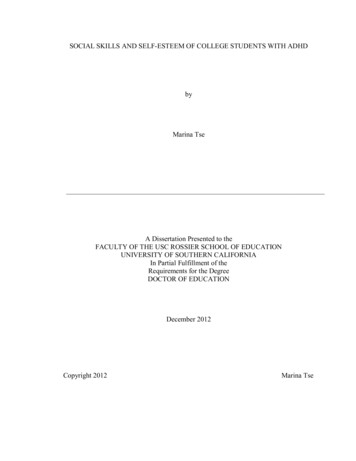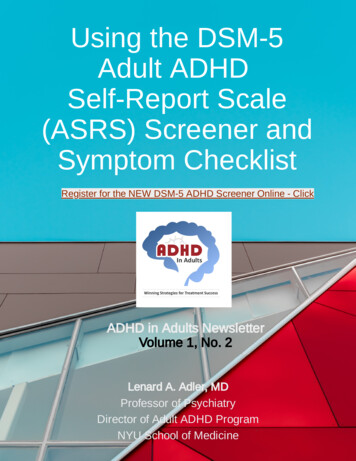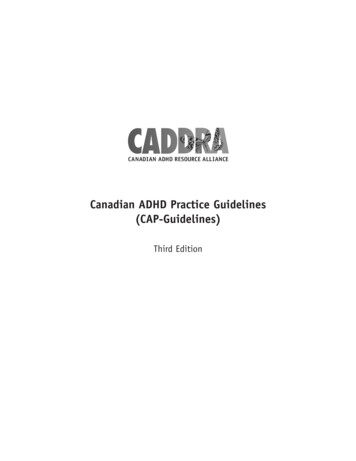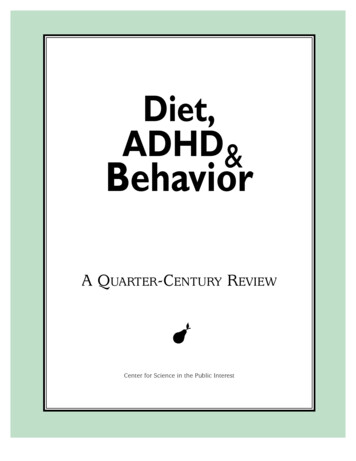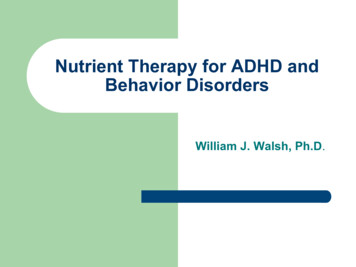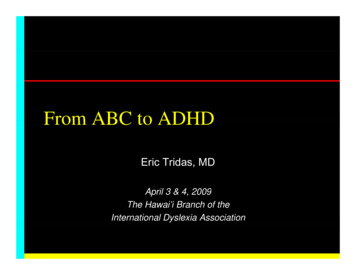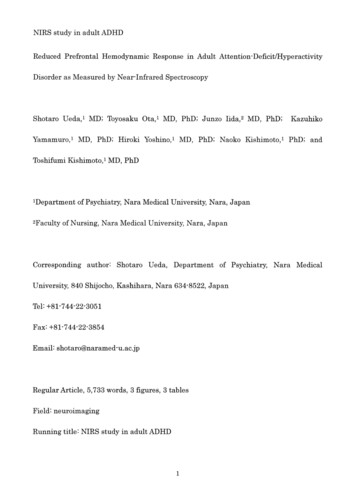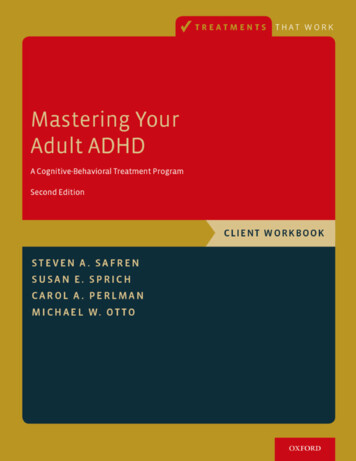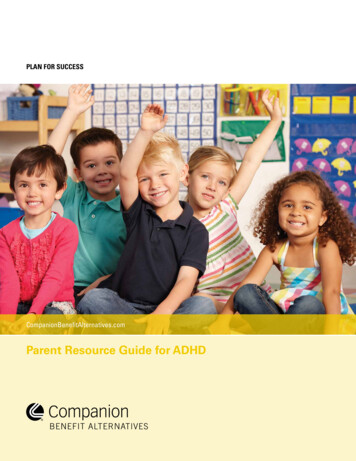
Transcription
Plan for successCompanionBenefitAlternatives.comParent Resource Guide for ADHD
3Welcome to Plan for SuccessParenting children with Attention Deficit Hyperactivity Disorder (ADHD) brings uniquechallenges. It also brings questions.Most parents wonder what steps they can take to help their children succeed. Workingwith your child’s doctor and learning more about ADHD are some important first steps.With this in mind, Companion Benefit Alternatives, Inc. (CBA) developed this guide toassist you. Plan for Success includes general information about ADHD, helpful tips formanaging your child’s ADHD symptoms and tools for monitoring progress.We hope this information helps your child succeed. CBA welcomes your feedback.Feel free to email us at CBA.Quality@CompanionGroup.com, or call us at800-868-1032, ext. 25331.Visit us at CompanionBenefitAlternatives.com
Guide for ADHDWhat is ADHD?Attention Deficit Hyperactivity Disorder (ADHD) is a condition that makes it hard for children to payattention or sit still. It is one of the most common childhood conditions.Symptoms of ADHD include inattention, hyperactivity and impulsivity. If left untreated, these behaviorscan cause difficulty at school, at home and with other activities.A child diagnosed with ADHD mayTalk constantlyHave a hard time paying attentionBecome easily distractedHave difficulty listeningForget thingsBe unable to stay seatedSquirm or fidgetAct and speak before thinkingInformation provided by the Centers for Disease Control and Prevention (www.cdc.gov)and the Substance Abuse and Mental Health Services Administration (www.samhsa.gov).
Guide for ADHDWhat is ADHD?There are three types of ADHD. Symptoms and behaviors vary for each.1.Predominantly Inattentive TypeThe child finds it hard to organize or finish a task, to pay attention to details, or to follow instructions or conversations.The child is easily distracted or forgets details of daily routines.2. Predominantly Hyperactive-Impulsive TypeThe child fidgets a lot and has difficulty sitting still for long periods. The child will also talk a lot, feel restless and havetrouble with impulsive behaviors. Impulsivity may include interrupting others, grabbing things from people or speakingat inappropriate times. It is difficult for the child to wait his or her turn or listen to directions.3.C ombined TypeThe child has symptoms of both types.Information provided by the Centers for Disease Control and Prevention (www.cdc.gov)and the Substance Abuse and Mental Health Services Administration (www.samhsa.gov).5
Guide for ADHDTreatment of ADHDChildren with ADHD can get better with treatment, but there is no cure. It is important to rememberthat treatments are not “one size fits all.” What works for one child may not work for another.Good treatment plans will include close monitoring by qualified professionals, follow-up care andany changes needed along the way. The most common treatments include medication, therapy or acombination of the two.Medication: Medication can be very helpful to a child with ADHD. Stimulants are the most common type of medication used totreat ADHD. They have been shown to yield positive results in a majority of children diagnosed with ADHD.Medications can affect children differently. Again, while one child may respond positively to one medication, another child mayhave a different response. Your child may need to try a few medications to see which one works best. Supervising your child’smedication is critical. Medication should only be given by a parent or other responsible adult.Communicate with your child’s doctor to find the right treatment plan for your child. It is important to understand the medicationthe doctor prescribes. Ask questions and read the information from the pharmacy.Your child should see his or her doctor within a few weeks after beginning medication for ADHD. The doctor will makesure the medication is working. Once your child has a good medication routine, he or she should see the doctor at leastevery three months.Therapy: Behavioral therapy is another treatment option that can help reduce behavioral problems related to ADHD. It shouldbe started soon after a child is diagnosed.Behavioral therapy can help teach children to control their behavior so they can do better at school and at home. Someexamples that may be effective in your child’s therapy include creating routines, getting organized, limiting distractions andusing goals and rewards.Combination: Many children do well with both medication and behavioral therapy.Information provided by the Centers for Disease Control and Prevention (www.cdc.gov)and the Substance Abuse and Mental Health Services Administration (www.samhsa.gov).
Guide for ADHDWorking with Your Child’s DoctorAlthough your child’s doctor will be asking many questions during appointments, you should alsoparticipate in the conversation. Don’t hesitate to ask questions.Asking the right questions can help you learn to better manage your child’s ADHD symptoms. Opencommunication between you, your child and your child’s doctor can lead to developing the besttreatment plan for your child. Here are some tips to get you started:n Communicatewith your child’s doctor regularly. Clinical guidelines recommend your child visit his or her doctorwithin one month after starting a medication for ADHD, with at least two follow-up visits within the following nine .)n Talkwith your child’s doctor about an overall plan of treatment. Over time, the treatment plan may change. As your childgrows, the doctor may change or adjust medication.n Also,a new school year may present different challenges requiring a specific behavior plan.n Learnall you can about ADHD. It’s a good idea to do your own research before your child’s appointment.Through research, you may be able to answer many of the questions you have about ADHD. At theappointment, ask your child’s doctor about recommended websites, books and other available tools.n Writedown a list of questions or points you want to discuss before going to doctor visits. Consider keeping a journal of yourconcerns or questions between visits. Keep track of things such as changes in your child’s behavior or reactions to medications.n Keepprogress charts to track symptoms and improvements and share these at doctor visits. Be sure to include grades andfeedback from teachers.n Informn Ifyour child’s doctor of any treatments or medications your child receives from other doctors or therapists.you notice side effects from the medication or have questions about your child’s treatment, contact the doctor.7
Guide for ADHDWorking with Your Child’s DoctorQuestions You May Want to Ask Your Child’s Doctor or Therapistn Whichtreatment do you think is best for my child and why?n Howdo you determine the recommended treatment?n Howwill ADHD affect my child over the long term?n Shouldn Doeswe try both medication and therapy?my child need medication, or can she/he betreated effectively without it?n Whatare the pros and cons and possible risks or sideeffects of this treatment?n Whattype of medication are you prescribing for mychild and how does it work?n Howwill the medication make my child feel, and howwill we know if it’s working?n Howlong before we see improvements?n Whatis behavioral therapy and how can it help improvemy child’s behavior?n Howwill my child be monitored during treatment?n Whatkind of impact can ADHD have on my child’sself-esteem and relationships?n Whatcan we do to improve these things?n Whatkind of ADHD education and support resourcesare available for parents and family members?n Arethere any daily lifestyle changes that can help bettermanage my child’s ADHD?n Howdo I effectively discipline my child?
Guide for ADHDDeveloping and Keeping RoutinesRoutines and organization play a large role in the success of children with ADHD. Children withADHD need structure. Routines are only helpful if you maintain them and use them frequently.Steps to developing routines:1. Make a checklist of what tasks must be done and prioritize them.2. Post the checklist in a place where you and your child can see it.3. Use rewards to reinforce completion of tasks.Other helpful tips for using routines:n Getspecific. Make sure the tasks are clear and measurable. For example, if you want your child to put up his or her toys,state exactly where the toys should go.n Puttasks in order and make sure your child completes each task before moving to the next item on the list. A schedule orcalendar can be helpful in keeping your child on track. Schedules allow for predictability and structure – both very importantin preventing negative behaviors in children with ADHD.n Remembern Bethat your main goal is to get your child to assume responsibility for himself or herself and to complete tasks.patient. New habits and skills take time to learn.Getting your child to follow directions:n Directionsn Given Beshould be direct, simple and clear.specific, step-by-step instructions and allow time for your child to complete one step before giving more instructions.firm and consistent.n Makeeye contact with your child when giving instructions.n Followup with appropriate reinforcement.9
Guide for ADHDn RewardsReinforce Desired Behaviorsor incentives can be powerful tools in helping your child succeed. Talk with your child’s doctor or therapist about waysto reinforce desired behaviors.n Rewardsn Trycan be small, but should be something your child wants, such as an extra 15 minutes of video game time.behavior charts. Completing these types of charts can help your child learn to track and monitor his or her own behavior. Behaviorcharts can be used to break down large jobs into smaller tasks, or can be a way for your child to keep up with daily chores.n Takesmall steps. Choose a few behaviors you would like to encourage. Explain to your child exactly what you expect from her orhim to earn a reward.n Provideopportunities for success. Be consistent with house rules and routines. Communicate these clearly to your child.Positive ReinforcementsNegative ConsequencesTangible rewards (e.g. toys)Missing a TV showA tripTimeoutA movieLoss of privilegesFavorite food or mealAn IOUYou will find several behavior and reward charts for your use in this resource guide.They are also available on our website at CompanionBenefitAlternatives.com.
Guide for ADHD11Ways To Encourage Your ChildThere are several ways your can tell your child that he or she has done a good job. Remember, positivereinforcement should be given soon after your child has completed the task.Instead of always saying “good job,” you could say:Awesome job!Good work!I’m very proud of you!Nice work!Fantastic!I appreciate your hard work!You did a great job!I knew you could do it!You outdid yourself today!You’re doing much better today!Excellent!Outstanding!Way to go!Terrific!Right on!Wonderful!
Guide for ADHDYour Child, ADHD and SchoolAlthough many children with ADHD face challenges in school, your child’s ADHD does not haveto interfere in the learning process. As you partner with your child’s teacher to develop helpfulstrategies for your child, school can be a positive experience.n Askabout school programs. Take advantage of special programs the school may offer specifically for children with ADHD.Schools are required by law to have programs and provisions in place for children who have a disability that interfereswith learning. Yourchild may qualify for services offered under Section 504 or the Individuals with Disabilities Education Act (IDEA).You can find more information on each of these programs through the U.S. Department of Education (www.ed.gov/parents)or your state’s own education website. Stayin communication with your child’s teachers. Start the year by requesting a conference with the teacher to discuss yourchild’s strengths and needs. Try to attend open house and scheduled parent-teacher conference days, but don’t feel that youmust wait for these days to talk with your child’s teacher.n Spendtime at your child’s school. Volunteer. Developing relationships at the school will expand your child’s support system.n Partnerwith your child’s teacher and be open to his or her suggestions. Support his or her efforts to help your child.Request that the teacher closely monitor your child’s work and provide feedback.n Makenotes on topics to explore with your child’s teacher. Some ideas for discussion include:— Set times for the class to write down assignments.— Class seating arrangements. Does your child need to beseated in the front of the classroom and/or away fromdoors or windows?n Find— Classroom strategies that have worked or notworked for your child in past grades.— Classroom routines.— Important test dates and project due dates.out what method of communication works best for you and your child’s teacher and use it regularly. Emailing isbecoming increasingly popular with teachers to communicate with individual parents or about a class. Phone calls andnotes in student planners are also options.
Guide for ADHD13Your Child, ADHD and SchoolWorking Through Assignments and Homeworkn Ifgetting your child to focus during homework time is an Taketime each evening to organize all school materials,problem, you may want to consider asking your child’spack book bags and place them in their designated area fordoctor to schedule a medication for later in the day sothe next day.that it lasts during the late afternoon and evening hours.n Askthe school if you can have an extra set of books forhome. Forgetting to bring books home (or the correct bookshome) happens often with many children with ADHD.n Checkif the school has a website for posting assignmentsand/or grades. Many schools also have a telephone “hotline”to check for homework assignments.n Encourageyour child to use a daily planner to writedown assignments. Take time to review the scheduleand assignments each day.n Assigna color code for each subject. If your child selectsn Setup a place for a permanent study/homework area inyour home away from distractions. Assign a specific timefor homework and have needed supplies on hand.n Comeup with homework rules; for example, no televisionor phone calls during homework time.n Makea habit of using timers during homework time. Timersallow students to monitor their own use of time.— For example, once your child gets home from school youmay want to allow him or her 30 minutes to eat a snackand relax. After that 30-minute break, set the timer for 30minutes of homework time. When the timer goes off, allowblue for math, only his or her math binders, notebooks,your child a break of about 10-15 minutes before startingbook covers and folders would be blue.another 30 minutes of homework.n Askyour child to file papers in binders and notebooksdaily. One way to use folders is to have assignments to becompleted on one side, while completed work ready to turnin is on the other side of the folder. This will help your childorganize assignments and tasks.
Guide for ADHDYour Child, ADHD and Summertime or VacationsSpeak to your child’s doctor about your summer plans or vacations before making any decisionsabout your child’s medication. There are several things you may want to consider before making anybig changes – like stopping medication treatment for the summer.Keep in mind that while routines are important for children with ADHD, summers and vacations canbe fun and flexible and still have structure. Make an effort to have plenty of free time but also plansome scheduled activities.Whatever your plans, remember that the ultimate goal is to make sure that your child has a positiveand fulfilling summer or vacation.Here are some things to consider:n Talkto your child’s doctor about adjusting your child’s medication schedule.n Don’tn Takestop all of your set routines. Keep some in place to keep structure and predictability in your child’s day.advantage of educational and recreational activities offered in your community. Check your local library or recreationcenter for available activities or camps your child can attend. Be sure to also include physical activities, such as walking,swimming and bike riding.
Guide for ADHDMaintain Positive Family RelationshipsCaring for a child with ADHD can be challenging for the entire family. Marriages and siblingrelationships are often strained by the stress associated with ADHD. There are many resourcesavailable that may help you and your family cope with the stress and other difficulties.n Ifyou and your spouse are frustrated about how to handle your child’s behavior and care, do your best to get on the samepage. Make sure that both of you are involved in your child’s treatment plan. Sit with your child’s doctor and come up witha treatment plan and other ideas that both of you can agree with.n Rememberyou are a team, so you must think like a team. Communicate with each other and support one another.Take time to nurture your relationship and keep it strong.n It’sOK to be frustrated. Schedule time with a mental health counselor or social worker to discuss your frustrations.He or she can also provide advice on raising a child with ADHD and coping with stress.n Finda support group for parents raising children with ADHD. Talking with those who share your experiences can be verybeneficial. Support groups are another way to find other available resources.n Don’tforget about your other children. If there are siblings in the household, make sure they get individual attention andquality time as well. They may not say anything or show how they are feeling, but making an effort to spend time with theother children can have a huge impact.n Takea break. Be sure to give yourself some time off every now and then. You need time to relax and get some rest.Ask family and friends for help.15
Guide for ADHDAdditional ResourcesPublications:Taking Charge of ADHD, Russell A. Barkley, PhD. New York: The Guilford Press, 2000.ADHD: Attention-Deficit Hyperactivity Disorder in Children and Adults, Paul H. Wender, MD. Oxford University Press, 2002.Straight Talk about Psychiatric Medications for Kids, Timothy E. Wilens, MD. New York: The Guilford Press, 1999.Websites:ADHD Parents Medication Guide (American Academy of Child and Adolescent Psychiatry and American Psychiatric Association,www.parentsmedguide.org/ParentGuide English.pdf)American Academy of Child & Adolescent Psychiatry (www.aacap.org)Attention Deficit Disorder Association (www.add.org)Children and Adults with Attention Deficit/Hyperactivity Disorder (www.chadd.org)Federation of Families for Children’s Mental Health (www.ffcmh.org)Medline Plus ADHD Information Page activitydisorder.html)Mental Health America (www.nmha.org)National Alliance on Mental Illness (www.nami.org)National Institute of Mental Health (www.nimh.nih.gov)National Resource Center on AD/HD (www.help4adhd.org)Substance Abuse and Mental Health Services Administration (www.mentalhealth.samhsa.gov)U.S. Department of Education (www.ed.gov/parents)
17Tools for Success
Guide for ADHDTools for SuccessProgress TrackerThis tool can be used to track your child’s symptoms on a weekly basis and to discuss your child’s progresswith his or her doctor or therapist.Tips for Doctor’s VisitsThis form provides a place to record all medications your child is taking, as well as topics you may want todiscuss with your child’s doctor at the next visit.Behavior ChartsThese charts can help your child in setting goals, keeping up with daily activities, and earning rewardsfor desired behaviors.Weekly Progress ChartsThese charts can be used to remind your child about his or her daily activities. These can also be used for settinggoals and earning rewards for desired behaviors.Reward CouponsThese coupons can be used as rewards your child can earn for completing the daily behavior, homeworkand weekly progress charts.If you need copies for future use, these tools and other information can be found on our websiteat CompanionBenefitAlternatives.com.
Guide for ADHD19Tracking progress of ADHD in childrenSymptoms of ADHD can affect many areas of your child’s life — from home to school to getting alongwith others. This tool can help you keep track of how you child is doing while on treatment.Before you fill in the tracker, make copies for future use. Each week, set aside some time to think overhow your child has been doing. Ask your child how he or she is doing in these areas. Talk with theteacher. Then, fill in the tracker. Over time you can track how well the treatment plan is helping yourchild. Be sure to share the progress and concerns with your child’s doctor. If symptoms are not gettingbetter, your child’s doctor can help by changing your child’s medicine, dosage or behavior therapy.Child’s nameDateCheck off how your child’s symptoms have been. (ThinkMedicineabout home, school and getting along with others.) Usethe blank spaces to make notes about when and wheresymptoms occur. Or, note any changes or concerns.Symptoms related to attentionRarely/NeverDosageChild’s weightOccasionallyOftenNotesHas trouble paying attentionHas trouble listening when spoken toHas trouble getting organizedMakes careless mistakesLoses thingsIs often forgetfulIs easily distractedSymptoms related to activityFidgets and squirms in seatHas trouble playing or working quietlyTalks a lotWalks, runs, or climbs when remainingseated is expectedIs often “on the go”Symptoms related to self-controlHas trouble waiting in line or taking turnsInterrupts conversations or gamesBlurts out answersImportant: Not every ADHD symptom is listed here. You may want to add some that your child has.Adapted from the American Psychiatric Association Diagnostic and Statistical Manual of Mental Disorders 4th ed. Text revision Washington, DC:American Psychiatric Association; 2000.
Guide for ADHDTips for Doctor VisitsBefore the next visit to your child’s doctor:n Giveyour child medicine as directed. Supervising your child’s medicine is critical. Medicine should be given only bya parent or other responsible adult. Read the label before you give the medicine.n Keepa record of all medicine your child is taking. (A sample record is provided.) Share this with all your child’sdoctors and therapists.n Followthe treatment plan. If your child has side effects from the medicine, or if you have questions about treatment,contact your child’s doctor right away.At the next visit, discuss any questions you have about medicine ortreatment, such as:n Whatare the brand and generic names of the medicine?n Whatsymptoms will this help?n Howsoon should I see results?n Howlong will my child have to take this medicine?n Whenshould this be taken?n Whatis the dosage prescribed for my child?n Whatshould I do if my child misses a dose?n Hown Areand where should I keep this medicine?there things my child should avoid while taking this medicine? Activities, foods, other medicines?n Whatn Cann Isside effects might my child have and what should I do about them?the prescription be refilled? How often? How do I get future prescriptions?there any written information I can take with me?Medicine Record: List all medications your child is currently taking, prescription and over-the-counter,to share with your child’s doctor.The chart on the next page can help you keep up with your child’s medications.
Guide for ADHDStartDateMedicine21Medicine RecordDosageHow OftenReasonSpecial Directions
Guide for ADHDHave a Happy Day!You are a star!I got out of bed on time.I got out of bed on time.I followed directions.I followed directions.I took my medicine.I took my medicine.I did my homework.I did my homework.I did my chores.I did my chores.I went to bed on time.I went to bed on time.If I color in six smiley faces, I earnIf I color in six stars, I earn.
23Guide for ADHDHave a Happy Day!You are a star!I got out of bed on time.I got out of bed on time.I followed directions.I followed directions.I took my medicine.I took my medicine.I did my homework.I did my homework.I did my chores.I did my chores.I went to bed on time.I went to bed on time.If I color in six smiley faces, I earnIf I color in six stars, I earn.
Guide for ADHDActivityWeekly t up and gotdressed on timeTook my medicineFollowed directionsFinished homeworkDid my choresWent to bed on timeIf I earn stickers for the week, I can .
Guide for ADHDActivity25Weekly t up and gotdressed on timeTook my medicineFollowed directionsFinished homeworkDid my choresWent to bed on timeIf I earn stickers for the week, I can .
Guide for ADHDThree Strikes ChartBehavior:Consequence:Strike 1Strike 2Strike 3Behavior:Consequence:Strike 1Strike 2Strike 3Behavior:Consequence:Strike 1Comments:Strike 2Strike 3
Guide for ADHDDay:S27Daily Success ChartMGot up and gotTWThFS4cdressed on timeDay:SMGot up and gotTWThFS4cdressed on timeTook my medicinecTook my medicinecFollowed directionscFollowed directionscFinished homeworkcFinished homeworkcDid my chorescDid my chorescWent to bed on timecWent to bed on timec
Guide for ADHDDay:SDaily Success ChartMTWThFSDay:SMTWThFS4c4ccccccccccc
Guide for ADHD29Student ChecklistI will:Get up on time and get dressedTake my medicineEat a good breakfastGather my school stuffGet settled in classTurn in homeworkFollow directionsFinish class workWrite down assignmentsBring books homeFinish homeworkGet school papers signed by parentGo to bed on timeOther things I need to do:MondayTuesdayWednesdayThursdayFriday
Guide for ADHDI will:Student ChecklistMondayTuesdayWednesdayThursdayFriday
Guide for ADHDBehavior ContractName:Date:These are my goals:1.2.3.These are my consequences if I don’t meet my goals:These are my rewards if I meet my goals:My contract will be reviewed on:Signature:31
Guide for ADHDBehavior “Think” SheetName:Date:I was not (circle all that apply):Following RulesFollowing DirectionsBeing NiceListeningBeing CooperativeAs a result (describe what happened):I should have:From now on, I will:My signature:Teacher:Parent(s):
Guide for ADHD33Assignment WorksheetName:Week:Monday:Teacher Initialed:Parent Initialed:Teacher Initialed:Parent Initialed:Teacher Initialed:Parent Initialed:Teacher Initialed:Parent Initialed:Teacher Initialed:Parent Initialed:Tuesday:Teacher Initialed:Parent Initialed:Teacher Initialed:Parent Initialed:Teacher Initialed:Parent Initialed:Teacher Initialed:Parent Initialed:Teacher Initialed:Parent Initialed:Wednesday:Teacher Initialed:Parent Initialed:Teacher Initialed:Parent Initialed:Teacher Initialed:Parent Initialed:Teacher Initialed:Parent Initialed:Teacher Initialed:Parent Initialed:
Guide for ADHDAssignment WorksheetThursday:Teacher Initialed:Parent Initialed:Teacher Initialed:Parent Initialed:Teacher Initialed:Parent Initialed:Teacher Initialed:Parent Initialed:Teacher Initialed:Parent Initialed:Friday:Teacher Initialed:Parent Initialed:Teacher Initialed:Parent Initialed:Teacher Initialed:Parent Initialed:Teacher Initialed:Parent Initialed:Teacher Initialed:Parent Initialed:Comments
Guide for ADHD35RewardsGood for 15 minutesof extra playtime.Good for reading oneextra bedtime story.Good for playing a gamewith Mom or Dad.Good for one tripto the park.Good for baking yourfavorite cookies.Good for onebig bear hug.
Guide for ADHD37RewardsGood for 15 minutesof extra videogame time.Good for purchase offive songs online.Good for playing a gamewith Mom or Dad.Good for popcornand a movie.Good for skippingone chore.Good for onebig hug.
Guide for ADHD What is ADHD? 5 There are three types of ADHD. Symptoms and behaviors vary for each. 1. Predominantly Inattentive Type The child finds it hard to organize or finish a task, to pay attention to details, or to follow instructions or conversations.
